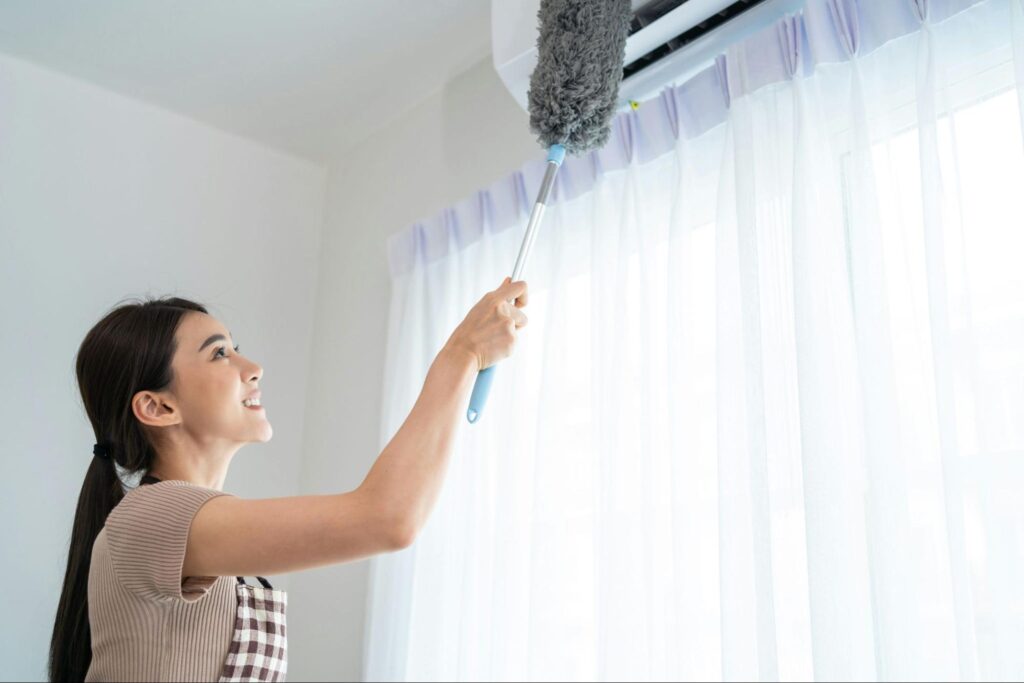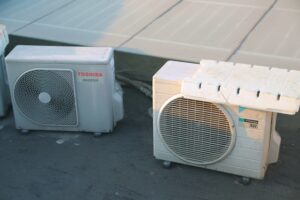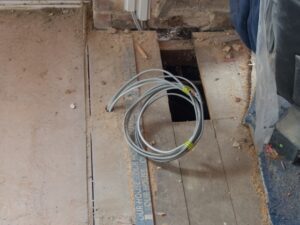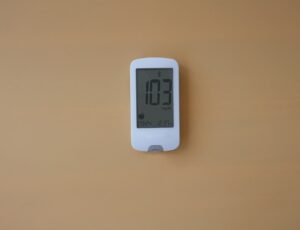Have you ever found yourself struggling with a broken air conditioning unit during the hottest months?
It can be a real headache, but what if you could tackle some of those pesky issues on your own?
While not all AC problems can be fixed without professional help, many simple repairs are easy to handle with the right knowledge and tools. DIY AC repairs can save you time and money, but safety and knowing your limits are always the priority.
Before you get started, always unplug the unit to ensure your safety. Simple fixes like clogged filters or dirty condenser coils can often be cleaned or replaced without much hassle. However, if the problem persists or you’re unsure about tackling it, that’s when experts like Excel Mechanical can step in to ensure your system is running smoothly.
Excel Mechanical offers HVAC and plumbing solutions that cater to both residential and commercial needs. Our team is dedicated to providing outstanding quality and value, making sure you get the right solution for your AC system, whether it’s a quick fix or a more complex issue.
In this blog, we will cover:
- The basic components of an AC unit and how they work.
- Essential safety tips to follow during DIY repairs.
- How to troubleshoot common AC issues and decide when to call a professional.
Here is everything you need to know:
Understanding Your AC System
Grasping the basics of your air conditioning system is crucial for effective DIY repairs. Knowing the components, functionality, and terminology helps you diagnose and fix issues confidently.
Components of an AC Unit
An air conditioning unit consists of several key parts.
The compressor is the heart of the system, pumping refrigerant through the AC.
The condenser and evaporator coils work together to absorb and release heat. Fans draw air over the coils to facilitate heat exchange.
Additionally, the expansion valve regulates refrigerant flow while the filter traps dust and particles.
Understanding these components and their roles in cooling ensures you can identify problems and consider repairs correctly. Each part plays a vital role in the system’s operation and efficiency.
How Your AC System Works
Your AC system operates in a series of stages.
- Initially, the compressor circulates refrigerant through the system.
- Using the evaporator coil, this refrigerant absorbs heat from the air inside your home. It then travels to the condenser coil outside, where the heat dissipates.
- Fans aid in moving air over these coils, enhancing the cooling process. The cycle repeats until the desired temperature is reached, which is crucial for effective cooling.
- Regular maintenance, like filter replacement and coil cleaning, ensures optimal performance.
By understanding these steps, you can troubleshoot common AC problems more effectively.
Common AC Terminology
Familiarity with AC terminology aids in communication and troubleshooting.
Key terms include BTU, a unit measuring cooling capacity, and SEER, which rates energy efficiency. Knowing these terms helps you compare AC units and understand their efficiency.
Terms like coolant (often called refrigerant) and thermostat are essential for grasping system functions. The blower, another vital component, circulates air throughout your home.
Using these terms will improve your ability to describe issues or needs when speaking with professionals.
Safety First
Safety is your top priority when doing AC repairs yourself. Be aware of electrical hazards and the proper handling of refrigerants to ensure your safety and the effective repair of your unit.
Electrical Safety Tips
Always turn off the power before working on your AC.
Use a multimeter to verify the circuit is dead. Wear rubber-soled shoes to reduce the risk of electric shock. Keep water and liquids away from electrical components to prevent accidents.
Label wires before disconnecting them to avoid confusion when reconnecting. Be mindful of sharp metal edges. A slip could result in cuts, so wear protective gloves.
Following these steps helps ensure your safety when handling electrical parts.
Handling Refrigerant
Refrigerant is a crucial part of your AC system but can be hazardous if mishandled.
Wear protective goggles and gloves to prevent exposure to harmful chemicals, and work in a well-ventilated area to avoid inhaling fumes. It’s illegal to release refrigerant into the atmosphere.
Properly dispose of or recycle refrigerant according to local regulations.
Keeping these safety tips in mind reduces risks.
Troubleshooting Common Issues
When your air conditioner isn’t working properly, the first step is to pinpoint the issue and get it fixed. Whether it’s weak airflow or an incorrect thermostat, each problem requires a unique approach.
Let’s explore some key issues and how to tackle them.
Identifying the Problem
Finding out what’s wrong with your air conditioner starts with a visual inspection and noting any unusual sounds.
Is the unit making strange noises or failing to start? Are there any visible leaks or puddles?
These signs can guide you toward the issue.
Listen for any humming or rattling, as these may indicate loose parts. Check for dust accumulation on filters and vents, often leading to reduced efficiency. Handy tools like a flashlight or a multimeter can be essential in this step.
Regular checks can prevent more serious conditions from developing.
Issues with Airflow
Reduced airflow often points to clogged filters or blocked vents.
Start by inspecting and cleaning your air filters.
Clogged filters cause the system to work harder, leading to potential damage and increased energy costs. Clean or replace them regularly to ensure efficient operation.
Also, check vents to ensure they are open and unblocked. You can move furniture or other objects that are obstructing airflow.
Thermostat Malfunctions
A malfunctioning thermostat can often mislead you about your home’s temperature.
Ensure it’s set correctly and switch it from “cool” to “off” and back. The display might need new batteries or a restart if it is blank or unresponsive.
Verify the settings to ensure they match your comfort levels. If issues persist, you might need to recalibrate or replace the thermostat. Digital thermostats sometimes require cleaning of internal components.
Consistent thermostat issues might mean it’s time for a more advanced model.
Refrigerant Leaks
Refrigerant is crucial for cooling, and any leaks can reduce efficiency or stop the unit from cooling entirely. If you notice hissing sounds or ice forming on the outdoor unit, this could be a sign of a leak.
Reduced cooling performance often indicates low refrigerant levels. While you can check for oily residues or wet spots around the unit, fixing leaks requires professional attention.
Electrical Failures
If your AC unit isn’t turning on, explore potential electrical issues.
Tripped breakers or blown fuses could be the culprit. If necessary, head to your electrical panel to inspect and reset these elements. Frequent tripping might indicate a more serious electrical problem.
Inspect any visible wiring for damage or wear, but avoid handling anything potentially dangerous. Always prioritize safety.
If you encounter complex electrical problems, seeking professional assistance is wise to prevent risks or further damage.
Maintenance Practices
Keeping your air conditioning system in top shape requires regular attention to some key maintenance tasks. These practices keep your unit running efficiently and help prevent unexpected breakdowns.
Routine Cleaning
Routine cleaning is essential to maintain the efficiency of your AC unit.
Dust and debris can accumulate on the coils and other components, reducing performance. To clean your unit, turn off the power to ensure safety. Use a soft brush or a vacuum with a brush attachment to remove dust from the coils and case gently.
Regular cleaning can reduce energy costs by improving the system’s airflow. Clean any visible dirt from vents and ducts to ensure unobstructed air circulation.
Making this a regular maintenance routine can extend your AC’s lifespan and improve indoor air quality.
Replacing Filters
Replacing filters is one of the simplest yet most impactful maintenance tasks.
Filters trap dust, pollen, and other particles that can affect air quality. Over time, these filters become clogged, reducing airflow and forcing the AC to work harder.
Check your filters monthly, especially during heavy use periods like summer, and replace them if they look dirty. Depending on your system’s specific requirements, most filters should be replaced every 1-3 months.
This simple step can enhance efficiency and provide cleaner air in your home or office.
Checking Refrigerant Levels
Checking refrigerant levels is crucial for optimal AC performance.
Low refrigerant can lead to higher energy bills and reduced cooling capability. If your AC isn’t cooling as effectively, it might be an issue with the refrigerant.
While this task might seem complex, professional help is often the best choice. Spend wisely on professional maintenance to ensure your system runs smoothly year-round.
DIY Repair Techniques
Learning some simple DIY techniques can extend the life of your air conditioning system. Addressing issues like clogged drain lines, bent fins, and air leaks can keep your unit running efficiently.
Unclogging the Drain Line
A clogged drain line can cause water to back up and damage your AC unit.
To ensure safety, turn off your air conditioner. Find the drain line, usually a PVC pipe, and place a small bucket underneath it. Remove the cap or plug if there is one. Use a wet/dry vacuum to suction out debris or standing water.
Pouring a mix of equal vinegar and water into the drain line can also help break up clogs. Let it sit for an hour before flushing it with water.
Regular maintenance can prevent future clogs, so consider repeating this process every few months.
Fixing the Fins
Bent fins on your AC unit can disrupt airflow and decrease efficiency.
Before making any repairs, turn off the power to your unit. Use a fin comb, a specialized tool that can gently straighten the fins. Starting from the bottom, slide the comb upwards through each fin row.
Be careful not to apply too much pressure, as the fins can be delicate. In some cases, carefully using a butter knife or a flat-head screwdriver can also help realign them. Keeping the fins clean is vital.
Rinse them gently with a hose to remove any dirt or debris.
Sealing Air Leaks
Air leaks in your HVAC system can lead to energy loss and higher utility bills.
Check ductwork for any visible cracks or gaps. Use foil tape or mastic sealant to cover these areas securely. The seals help keep the air inside and maintain consistent temperatures.
It’s also a good idea to inspect windows and doors. To enhance insulation, apply weather stripping or caulk. Proper sealing helps your AC work less hard, saving you money in the long run.
For more complex repairs, it’s wise to call in the professionals.
When to Call a Professional
It’s essential to recognize your limits when dealing with air conditioner repairs. While some issues can be managed independently, complex problems or severe damage require expert intervention to ensure safety and proper functioning.
Assessing Repair Complexity
Before tackling a repair, take a good look at the problem. If it involves minor tasks like replacing a filter or checking the thermostat, you might handle it yourself. Use online guides and resources, but ensure they are credible and clear.
Warning signs of complex issues:
- Frequent leaks or pooling water
- Strange noises or odors
- Inconsistent temperatures or no cooling at all
Issues involving electrical components or refrigerant leaks demand professional attention. Not only are these complex, but they can also pose safety risks if mishandled. When faced with such problems, it’s best to reach out to trained technicians equipped to handle these challenges safely and effectively, ensuring your system works optimally.
Finding a Qualified Technician
Start by looking for licensed professionals with a solid reputation.
Seek recommendations from friends or look for reviews online. Qualifications like certifications in HVAC systems highlight a technician’s expertise.
Key factors to consider:
- Years of experience
- Customer service quality
- Clear, upfront pricing
Excel Mechanical stands out as a top choice for HVAC and plumbing services. We carefully assess your unique needs and budget and are known for exceptional quality and personalized service. With skilled technicians ready to offer reliable solutions, you can trust your system is in capable hands.
Choosing experts ensures repairs are performed correctly, preventing future problems.
Preventive Measures and Upkeep
Efficient operation and longevity of your AC depend on regular maintenance and timely upgrades. Keeping these aspects in check helps reduce breakdowns and increases energy efficiency.
Seasonal AC Maintenance
Regular upkeep is essential regardless of the season.
- During spring, focus on cleaning or replacing air filters to ensure proper airflow. Clean filters prevent strain on the system and maintain air quality.
- In summer, check the refrigerant levels to keep your unit running smoothly. Low refrigerant can lead to higher electricity bills and affect cooling performance. Inspect the coils and remove any dirt or debris, as clean coils improve heat exchange, leading to efficient cooling.
- Fall is the time to look for worn-out parts like belts and hoses. Replacing these ahead of time prevents sudden failures.
- In winter, cover the unit to protect it from dust and elements even if your AC isn’t in use.
Consider a professional check-up to ensure your system is ready for the next cooling season.
Upgrading Your AC System
Sometimes, maintenance alone is not enough.
Upgrading parts or the entire system can significantly improve efficiency and comfort. If your AC system is over ten years old, consider a high-energy-efficient model to save on energy bills.
Modern AC units often have smart thermostats. Installing one helps manage temperatures effectively and reduce energy consumption. It’s a small upgrade with significant benefits.
Excel Mechanical offers customization options for both residential and commercial needs. If you’re uncertain about upgrades, consulting professionals like us can ensure you invest wisely.
We balance quality and value, delivering a system tailored to your requirements and budget.
Frequently Asked Questions
When it comes to DIY AC repairs, many of us want to know, “Can I fix this myself?” While some issues are simple enough to handle, others might require a bit more expertise. Let’s dive into some of the most common questions people ask about AC repair, and how you can determine whether you need to roll up your sleeves or call in the pros.
How can I troubleshoot my home air conditioner that is not cooling?
Check your thermostat settings to ensure it’s set to “cool” and the fan is on “auto” or “on.” Then, inspect the air filter for dirt or clogs, replacing it if necessary. Finally, examine the outdoor unit for blockages or debris hindering airflow.
What steps are involved in repairing a car’s AC system by myself?
Start by checking the refrigerant level, as this is a common issue. Locate the refrigerant port under your hood and connect a pressure gauge. If needed, recharge with the correct type of refrigerant. Then, verify that all connections are secure and examine belts and hoses for wear or damage.
Why is my air conditioning unit running but not reducing indoor temperature?
This could result from a refrigerant leak or thermostat issue. Ensure the thermostat is functioning properly and set to the correct temperature. Then, inspect the coils within the unit for dirt or ice accumulation, as these issues can affect efficiency.
What are the common DIY repairs for a household AC malfunction?
Common repairs include cleaning or replacing air filters and ensuring vents are not blocked. Clear debris from outside units and check the thermostat settings. If the unit is equipped with a drain pan, ensure it is free of obstructions to avoid water leakage.
Can a homeowner legally perform air conditioner repairs without a professional?
Depending on local regulations, simple repairs like changing filters or cleaning coils may be allowed. Complex tasks such as handling refrigerant often require certification. Always review the rules in your area before making repairs.
What safety precautions should be taken when attempting to fix an AC unit?
Ensure the power to the unit is turned off before starting any work. Use insulated tools to avoid shock, and wear safety goggles and gloves to protect against refrigerant exposure. If unsure of the process, consulting an expert like Excel Mechanical can ensure a safe and effective repair.




